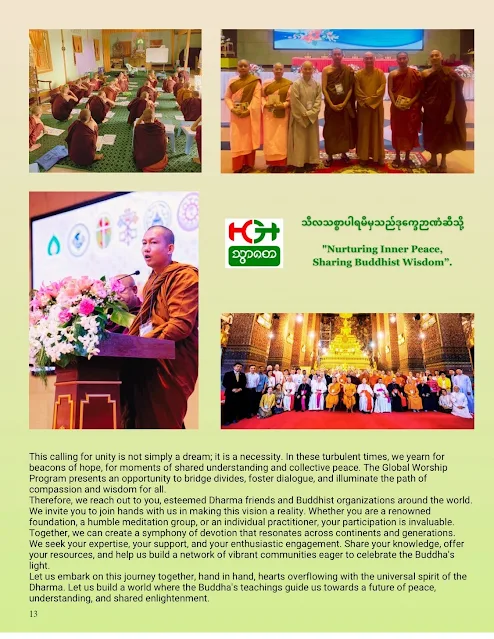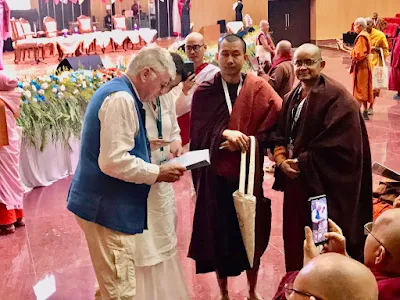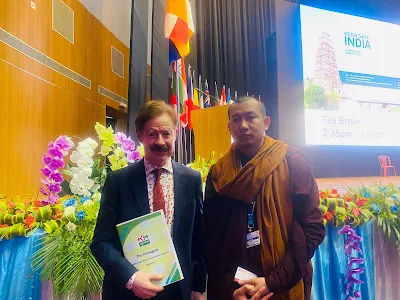anekajātisaṃsāraṃ sandhāvissaṃ anibbisaṃ gahakāraṃ gavesanto dukkhājāti punaṃppunaṃ sabbā te phāsukā aggā gahakūṭaṃ visaṅkhataṃ visaṅkhāra gataṃ cittaṃ taṇhānaṃ khaya majjyagā
ဝန္ဒာမိ
Wednesday, February 14, 2024
The Silver Scroll Inscription from Taxila
The Silver Scroll Inscription from Taxila
Discovery & Context
In 1914 CE (2457 BE), Sir John Marshall, a renowned archaeologist, excavated the Dharmarajika Stupa in Taxila (a UNESCO World Heritage Site). This stupa, originally built during Emperor Ashoka’s reign (3rd century BCE), underwent multiple renovations. Within the stupa, Marshall discovered a silver scroll inscription housed in a stone casket. The text, written in mixed Prakrit-Sanskrit using the Kharoṣṭhī script, was deciphered by Professor Sten Konow.
Inscription Text & Translation
Original (Kharoṣṭhī Script):
𐨯𐨎 𐩄 𐩅 𐩀 𐩃 𐩄 𐩃 𐩀 𐩀 𐨀𐨩𐨯 𐨀𐨮𐨜𐨯 𐨨𐨱𐨯 𐨡𐨁𐨬𐨯𐨅 𐩄 𐩃 𐩀 𐨀𐨁𐨭𐨅 𐨡𐨁𐨬𐨯𐨅 𐨤𐨿𐨪𐨡𐨁𐨯𐨿𐨟𐨬𐨁𐨟 𐨦𐨒𐨬𐨟𐨆 𐨢𐨚𐨂 𐨀𐨂𐨪𐨯-
𐨐𐨅𐨞 𐨀𐨁𐨣𐨿𐨟𐨱𐨁𐨪𐨁𐨤𐨂𐨟𐨿𐨪𐨅𐨣 𐨨𐨱𐨁𐨫𐨁𐨣 𐨞𐨆𐨀𐨕 𐨣𐨒𐨿𐨪𐨅 𐨬𐨯𐨿𐨟𐨬𐨅𐨣 𐨟𐨅𐨣 𐨀𐨁𐨨𐨅 𐨤𐨿𐨪𐨡𐨁𐨯𐨿𐨟𐨬𐨁𐨟 𐨦𐨒𐨬𐨟𐨆 𐨦𐨿𐨟𐨂 𐨢𐨨𐨿𐨪-
𐨅𐨟𐨿𐨐𐨿𐨮𐨁𐨫𐨅 𐨟𐨞𐨂𐨬𐨅 𐨨𐨱𐨪𐨗𐨯 𐨪𐨗𐨯 𐨡𐨁𐨬𐨤𐨂𐨟𐨿𐨪𐨯 𐨑𐨂𐨭𐨞𐨯 𐨀𐨪𐨆𐨒𐨡𐨿𐨐𐨿𐨮𐨁𐨞𐨅
𐨯𐨿𐨪𐨬𐨦𐨂𐨢𐨩 𐨤𐨂𐨩𐨅 (𐨤𐨂𐨗𐨩𐨅) 𐨤𐨕𐨗𐨦𐨂𐨢𐨩 (𐨤𐨕𐨗𐨦𐨂𐨢𐨅𐨞) 𐨤𐨂𐨩𐨅 (𐨤𐨂𐨗𐨩𐨅) 𐨀𐨪𐨵𐨞𐨿𐨟𐨩 (𐨀𐨪𐨵𐨞𐨿𐨟𐨩𐨞𐨿) 𐨤𐨂𐨩𐨅 (𐨤𐨂𐨗𐨩𐨅) 𐨯𐨿𐨪𐨬𐨯𐨿𐨟𐨬𐨩𐨞𐨿 𐨤𐨂𐨩𐨅 (𐨤𐨂𐨗𐨩𐨅) 𐨨𐨚𐨤𐨁𐨟𐨂 𐨤𐨂𐨩𐨅 (𐨤𐨂𐨗𐨩𐨅) 𐨨𐨁𐨟𐨿𐨪𐨨𐨕𐨗𐨚𐨁𐨯-
𐨫𐨆𐨵𐨁𐨟𐨞 𐨤𐨂𐨩𐨅 (𐨤𐨂𐨗𐨩𐨅) 𐨀𐨟𐨬𐨞𐨆 𐨀𐨪𐨆𐨒𐨡𐨿𐨐𐨿𐨮𐨁𐨞𐨅 𐨞𐨁𐨬𐨞𐨅 𐨨𐨆𐨟𐨂 𐨀𐨩 𐨡𐨅𐨩𐨯𐨿𐨨𐨤𐨿𐨪𐨁𐨕𐨒𐨆
Transliteration:
*Saṃ 136 20 10 4 1 1 ayasa aṣāḍhasa māsasa divase 10 4 1 iṣe divase pradisṭāvita bhagavato dhātu uras-*
keṇa intahariputrena bahalinoaca nagare vāsṭavena tena ime pradisṭāvita bhagavato bhatu dhamra-
e Takṣaśilāe taṇuve bodhisatvagṛhe mahārājasa rājātirājasa devaputrasa Khuṣāṇasa aroga-dakṣiṇe
sarvabuddhāna pūye (pūjāye) pratyekabuddhāna (pratyekabuddhānāṃ) pūye (pūjāye) arhatāna (arhatānāṃ) pūye (pūjāye) sarvasatvānāṃ pūye (pūjāye) mātāpitṛ pūye (pūjāye) mitramacañāti-
svalohitāna pūye (pūjāye) atavaṇo aroga-dakṣiṇe nivaṇe hotu aya deyasamaparicāgo
Translation:
*"In the year 136, on the 15th day of the month of Āṣāḍha, on this very day, the relics of the Blessed One (Buddha) were enshrined by Urasaka, a native of Antvhria (Bactria), residing in the city of Noaca. These relics were installed in the private chapel of the Bodhisattva within the Dharmarajika Stupa of Taxila, for the welfare of the Great King, the Supreme Ruler, the Divine Son of the Kushan dynasty, and in honor of:
All Buddhas,
All Pratyekabuddhas (solitary enlightened ones),
All Arhats (perfected beings),
All sentient beings,
One’s mother and father,
All friends and blood relatives.
This donation is also for the health and Nirvana of the donor himself. May this act of merit lead to liberation."*
(Sten Konow, Kharoshthi Inscriptions, p. 77)
Historical Significance
Identifies the Stupa’s Name
Confirms the stupa as "Dharmarajika", linking it to Ashoka’s legacy.
Mentions Taxila’s Ancient Name
Uses "Takṣaśilā", the original Sanskrit name for Taxila.
Kushan-Greek Rule
Dates to 89 CE (632 BE), during the reign of:
King Azes (Indo-Scythian/Greek-descended ruler).
Kujula Kadphises (founder of the Kushan Empire).
Donor’s Origins
Urasaka, the donor, was a Bactrian Greek from Noaca (exact location unknown).
Current Location
The silver scroll is displayed at the National Museum, New Delhi, India.
Key Takeaways
One of the earliest inscriptions confirming Taxila’s Buddhist heritage.
Reveals syncretism of Greek, Scythian, and Kushan cultures in Gandhara.
Highlights the global connections of ancient Buddhist patrons (Bactria → Taxila).
Sunday, February 11, 2024
Saturday, February 10, 2024
Inscriptions from Pataliputra
Pataliputra (Pāṭaliputta) was the capital of several Indian dynasties, initially built under King Ajātasattu (Ajatashatru) of Magadha. The king entrusted Vassakāra and Sunidha, two Brahmin ministers, with its construction as a strategic base for his campaign against the Vajjī Confederacy.
In the Pali Canon, the city is more frequently referred to as Pāṭaligāma (41 mentions) rather than Pāṭaliputta (3 mentions). Today, the site is known as Patna, the capital of Bihar state.
Inscriptions from Bharhut Stupa
The Bharhut Stupa, located in Satna District, Madhya Pradesh, features donations from patrons of Pataliputra. Dating back to around 200 BCE (350 BE), six inscriptions have been found, two of which are presented here:
Inscription 1 (Catalog No. A13)
Script: Brāhmī
Language: Prakrit
Text:
Line 1: Pāṭaliputasa Mahidasenasa dānaṃ
Translation:
"The gift of Mahidasena from Pataliputra."
Inscription 2 (Catalog No. A14)
Script: Brāhmī
Language: Prakrit
Text:
Line 1: Yāniyā dānaṃ
Line 2: Pāṭaliputasa Nāgasenāya Koḍi-
Translation:
"This gift is from the lay devotee Nāgasena of the Koḍiyani clan, from Pataliputra."
Note: This inscription is unusual because the first line (which would normally appear at the bottom) is placed at the top instead.
Current Location
These inscriptions are now housed in the Indian Museum, Kolkata (Calcutta), West Bengal, India.
Significance
These records highlight the religious patronage from Pataliputra’s elite, demonstrating the city’s influence in early Buddhist art and architecture. The Bharhut Stupa itself is a key monument of Śunga Dynasty art, blending narrative reliefs with donor inscriptions.
Embracing Unity through Relic Preservation and Peace-Building
Mahantā mugga māsāca, majjhimā bhindataṇḍulā.
Khuddakā sāsapamattā, tepi gacchāmi dhātuyo.
As I reflect on the journey that began around 2015 and continues to this day, I am reminded of the profound encounters and meaningful connections forged in the pursuit of preserving the historic Buddha Relics. As a young monk entrusted with the title of "The Guardians of Enlightenment" or Siridantamahāpālaka, I have navigated through diverse landscapes of challenges and triumphs, all in service of a sacred mission.
In the course of leadership, I have embraced myriad roles: from stewardship and protection to advocacy and outreach. With limited resources but boundless determination, I have remained steadfast in upholding our mission's clarity of purpose, vision, and core values. Each step forward has been marked by unwavering commitment to our ethical principles and standard operating procedures.
The pages of this magazine bear witness not only to our endeavors in relic preservation but also to the ripple effects of peace-building initiatives and ongoing programs that extend far into the future. To all who have contributed to this journey, I extend my deepest gratitude. Your support and dedication have been the cornerstone of our collective progress.
As we convey the essence of our message through these words, we extend an open invitation for collaboration and partnership. Hswagata embraces a universal vision: that the teachings of Buddha transcend borders, belonging to all humanity and promoting equality and peace. We welcome suggestions, cooperation, and the exchange of ideas with individuals, institutes, foundations, universities, and societies alike.
In the spirit of our motto, "Preserving Sacred Essence, Guiding Souls to Light," let us illuminate the path together towards a brighter, more harmonious world.
Bhikkhu Indasoma , Founder
Ph.D(Candidate),M.A,B.A,Dip in Social Work,Master Trainer(EIU),SCORE Trainer(ILO),FCTOT
Siridantamahāpālaka/The Guardians of Enlightenment .
The Hswagata Buddha Tooth Relics Preservation Museum
siridantamahapalaka@hswagatatoothrelics.com
Letter From Patron
On behalf of all the patrons and supporters of Hswagata noble mission, I extend heartfelt gratitude and appreciation for Hswagata unwavering dedication to the preservation of the historic Buddha Relics. Bhikkhu Indasoma’s tireless efforts, steadfast leadership, and commitment to promoting peace and unity resonate deeply with us all.
Since the inception of this sacred endeavor in 2015, we have witnessed the remarkable impact of Hswataga Missionary work on both a local and global scale. Phara Dhammasami @ Venerable Indasoma , his leadership has not only ensured the protection and promotion of these precious relics but has also ignited a beacon of hope and inspiration for humanity.
His clear vision, steadfast adherence to ethical principles, and tireless pursuit of excellence have set a shining example for all who aspire to make a meaningful difference in the world. Through the team collaborative spirit and unwavering dedication, we have not only preserved sacred essence but have also guided countless souls towards the light of enlightenment and peace.
As patrons and supporters, we stand in awe of Hswagata Management Team’s achievements and remain steadfast in our commitment to stand by his side. Your call for future cooperation and partnership resonates deeply with us, and we eagerly anticipate the opportunity to join hands with you in shaping a better world for generations to come.
In the spirit of unity and shared purpose, let us continue to illuminate the path together, guided by the timeless wisdom of the Buddha and fueled by the unwavering commitment to promoting peace and harmony for all.
With deepest appreciation and warmest regards,
Asst. Prof Dr.Phrapalad Soravit Aphipanyo
Faculty of Education, MCU, Thailand
Patron of the Hswagata Buddha Tooth Relics Preservation Museum
Wednesday, February 07, 2024
Inscription of Monk Buddhavarman
This inscription is also known as the Ghori Matani Inscription. It was excavated in Ghori Matani, located in the Attock District of Punjab Province, Pakistan. Written in a mix of Prakrit and Sanskrit using the Kharoṣṭhī script, the inscription reads:
Line 1: Saṃ 20 mahārājasa rājātirājasa devaputrasa Kaniṣkasa
Line 2: Jeṭha māsa dive pṛathame Budhavaruṃasa śamaṇasa posavapu-
Line 3: trasa Majhilakasa Kimanoputasa Rovimasa
Translation:
"In the 20th year of the great king, the supreme ruler, the divine son, Kanishka, on the first day of the month of Jyeshtha (Pali: Jeṭṭha), this religious gift belongs to the monk Buddhavarman, son of Posava (or Posavaputra), of the Majhilaka (or Madhyamaka) family, (and) son of Kimana (or Rovima)."
Summary:
This inscription belongs to Monk Buddhavarman, a Buddhist monk whose exact sect is not explicitly stated. However, it is highly likely that he belonged to the Sarvāstivādin Sect, which was the dominant school during the reign of King Kanishka of the Kushan Empire. The inscription dates back to 103 CE (646 BE), during Kanishka’s rule, and explicitly mentions his name, making it a historically significant artifact.
Embracing Through Relics Preservation and Peace-Building
In the course of leadership, I have embraced myriad roles: from stewardship and protection to advocacy and outreach. With limited resources but boundless determination, I have remained steadfast in upholding our mission's clarity of purpose, vision, and core values. Each step forward has been marked by unwavering commitment to our ethical principles and standard operating procedures.
The pages of this magazine bear witness not only to our endeavors in relic preservation but also to the ripple effects of peace-building initiatives and ongoing programs that extend far into the future. To all who have contributed to this journey, I extend my deepest gratitude. Your support and dedication have been the cornerstone of our collective progress.
As we convey the essence of our message through these words, we extend an open invitation for collaboration and partnership. Hswagata embraces a universal vision: that the teachings of Buddha transcend borders, belonging to all humanity and promoting equality and peace. We welcome suggestions, cooperation, and the exchange of ideas with individuals, institutes, foundations, universities, and societies alike.
In the spirit of our motto, "Preserving Sacred Essence, Guiding Souls to Light," let us illuminate the path together towards a brighter, more harmonious world.
Bhikkhu Indasoma , Founder
Ph.D(Candidate),M.A,B.A,Dip in Social Work,Master Trainer(EIU),SCORE Trainer(ILO),FCTOT
Siridantamahāpālaka/The Guardians of Enlightenment .
The Hswagata Buddha Tooth Relics Preservation Museum
founder@buddhatoothrelics.com
Saturday, January 20, 2024
Our Vision
To uphold and honor the sacred Buddha tooth Relics, while promoting the universal wisdom and compassion found within Buddhism. We envision a world where individuals find inner peace, harmony, and understanding through the practice and teachings of Buddhism. Our aim is to be a leading organization in preserving, promoting, and fostering the values of Buddhism, contributing to a more peaceful and enlightened society.Sao Dhammasami "Siridantamahāpālaka"
ABOUT HSWAGATA BUDDHA TOOTH RELICS PRESERVATION MUSEUM
ABOUT HSWAGATA BUDDHA TOOTH RELICS PRESERVATION MUSEUM
The Hswagata Buddha Tooth Relics Preservation Museum in Myanmar was founded by Venerable Dhammasami. The main purpose of the museum is to nurture inner peace and share Buddhist wisdom with visitors.
The museum is guided by several core values, which include reverence, authenticity, compassion, wisdom, education, collaboration, integrity, environmental stewardship, culture appreciation, and service. These values shape the activities and ethos of the museum.
The mission of the museum is to preserve, promote, and embody the wisdom and compassion of Buddhism. This is achieved through the reverence and preservation of the Buddha Tooth Relics, which are considered sacred artifacts within the religion.
By preserving these relics, the museum seeks to elevate the understanding and appreciation of Buddhism, while also providing a space for visitors to experience inner peace and spiritual growth. The museum also aims to promote the teachings of Buddhism through educational initiatives and collaborations with other organizations.
In addition, the museum emphasizes the importance of environmental stewardship and cultural appreciation, recognizing the interconnection between Buddhism and the natural and cultural heritage of Myanmar. It also values service to the community, striving to make Buddhism's wisdom and compassion accessible to all.
Sao Dhammasami "Siridantamahāpālaka"
Monday, December 11, 2023
Manikyala: The Magnificent Stupa Near Islamabad, Pakistan
Manikyala: The Magnificent Stupa Near Islamabad, Pakistan
Historical Background
The Manikyala Stupa was built during the reign of the great Kushan emperor King Kanishka (around 100 CE / 643 BE) in the village of Manikyala, Punjab, Pakistan, located 36 km from Islamabad. This stupa commemorates a Jataka tale in which the Buddha, in a previous life as a hermit (ṛṣi), selflessly sacrificed his life to feed a starving tigress and her cubs.
Excavation & Discovery
In 1830 CE (2373 BE), General Charles Masson, a British explorer and archaeologist, excavated the stupa’s core and uncovered numerous artifacts. Among them was a copper reliquary casket inscribed in Kharoṣṭhī script (mixed Prakrit-Sanskrit), containing 13 lines of text.
The Inscription (Transcription & Translation)
Text (Kharoṣṭhī Script):
𐨯𐨎 𐩄 𐩃 𐩃 𐨀𐨅𐨟𐨿𐨪 𐨤𐨂𐨪𐨿𐨬𐨀𐨅 𐨨𐨱𐨪𐨗𐨯 𐨐𐨞𐨅
*Saṃ 18 4 4 etra pūrvaye mahārājasa Kaṇe-*𐨮𐨿𐨐𐨯 𐨒𐨂𐨮𐨣𐨬𐨭𐨯𐨎𐨬𐨪𐨿𐨢𐨐 𐨫𐨫
ṣkasa Guṣaṇavaṃśa-saṃvardhaka lala𐨡𐨜𐨞𐨩𐨒𐨆 𐨬𐨅𐨭𐨿𐨤𐨭𐨁𐨯 𐨐𐨿𐨮𐨟𐨿𐨪𐨤𐨯
Dhaḍaṇyago Vepasiṣa Kṣatrapasa𐨱𐨆𐨪𐨨𐨂𐨪𐨿𐨟𐨆 𐨯 𐨟𐨯 𐨀𐨤𐨣𐨒𐨅 𐨬𐨁𐨱𐨪𐨅
Horamurto sa tasa apanage vihāre𐨱𐨆𐨪𐨨𐨂𐨪𐨿𐨟𐨆 𐨀𐨅𐨟𐨿𐨪 𐨞𐨞𐨧𐨒𐨬𐨦𐨂𐨢𐨰𐨬
Horamurto etra ṇaṇa-bhagavato Buddhasya𐨤𐨿𐨪𐨟𐨁𐨯𐨿𐨟𐨬𐨩𐨟𐨁 𐨯𐨱 𐨟𐨀𐨅𐨣 𐨬𐨅𐨭𐨿𐨤𐨭𐨁𐨀𐨅𐨞 𐨑𐨂𐨡𐨕𐨁𐨀𐨅𐨣
pratiṣṭhāvayati saha tena Vepasiṣeṇa Khudaciṇeṇa𐨦𐨂𐨪𐨁𐨟𐨅𐨞 𐨕 𐨬𐨁𐨱𐨪𐨐𐨪𐨵𐨀𐨅𐨞
Bhṛiteṇa ca vihāra-karavahaṇena𐨯𐨎𐨬𐨅𐨞 𐨕 𐨤𐨪𐨁𐨬𐨪𐨅𐨞 𐨯𐨢 𐨀𐨅𐨟𐨅𐨞 𐨐𐨂
saṃveṇa ca parivāreṇa saha eteṇa ku-𐨭𐨫𐨨𐨂𐨫𐨅𐨣 𐨦𐨂𐨢𐨅𐨱𐨁 𐨕 𐨮𐨬𐨀𐨅𐨱𐨁 𐨕
śala-mūlena Budhehi ca svakehi ca𐨯𐨨𐨎 𐨯𐨡 𐨦𐨬𐨟𐨂
samaṃ sada bhavatu𐨧𐨿𐨪𐨟𐨪𐨯𐨿𐨬𐨪𐨦𐨂𐨢𐨁𐨯 𐨀𐨒𐨿𐨪𐨤𐨜𐨁𐨀𐨭𐨀𐨅
bhrātara Svarabuddhi-sa agra-pradīśaye𐨯𐨢 𐨦𐨂𐨢𐨁𐨫𐨅𐨣 𐨣𐨬𐨐𐨪𐨿𐨨𐨁𐨒𐨅𐨞
saha Budhilena nava-karmikeṇa𐨐𐨪𐨿𐨟𐨁𐨩𐨯 𐨨𐨰𐨅 𐨡𐨁𐨬𐨯𐨅𐨁 𐩅
kartiyasa māhe divase 20
Translation:
"In the 18th year of the great King Kanishka of the Kushan dynasty, the lay devotee Vepasi (of the Kshatrapa clan) enshrined numerous relics of the Blessed Buddha in his own monastery. This act was performed together with three others: Vepasi, Khudasi, and Bhrita, along with their retinue. By the merit of this deed—and through the roots of virtue planted by the Buddha and his disciples—may this bring supreme benefit to my elder brother, Svarabuddhi, as well as to Budhila, the supervisor of construction. Dated the 20th day of the month of Karttika (the first month)."
Patrons & Purpose
Built by three lay devotees in Year 18 of Kanishka’s reign (likely 118 CE).
Dedicated to the Buddha’s relics and the Jataka of the selfless hermit.
Architectural & Religious Context
Reflects the Kushan Empire’s Buddhist patronage under Kanishka.
The Karttika month (Oct-Nov) aligns with post-monsoon construction in ancient India.
Current Location of Artifacts
The copper casket and relics are now displayed at the British Museum, London.
The Manikyala Stupa stands as a testament to Kushan-era Buddhist devotion, blending art, legend, and history. Its inscription provides rare insights into donor practices and imperial-era religious culture in ancient Gandhara.





































